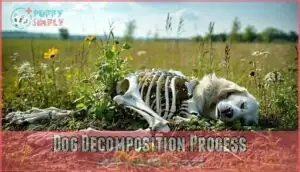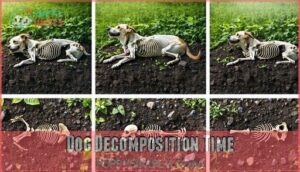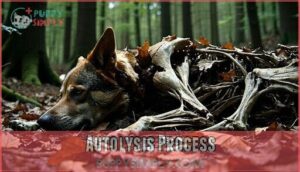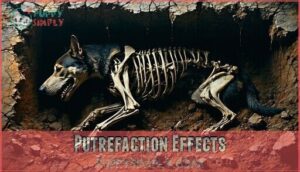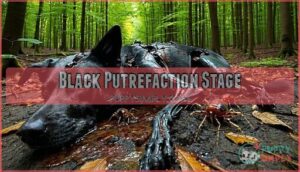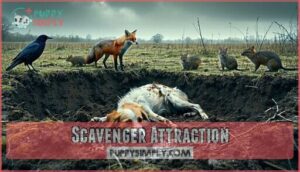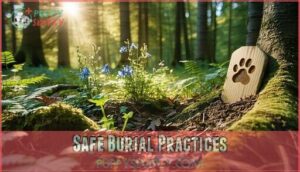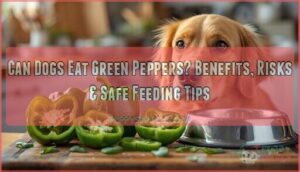This site is supported by our readers. We may earn a commission, at no cost to you, if you purchase through links.
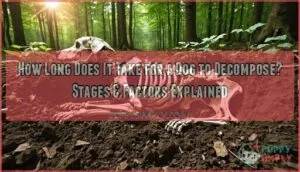
Above ground, a dog usually decomposes within 3 to 6 months, but underground this process slows, ranging from 6 months to 18 years.
Smaller dogs break down faster than larger breeds, as less tissue means less work for nature’s recycling team.
Warm climates speed things up, while colder temperatures and deeper graves put the brakes on decomposition.
If buried in a sealed coffin, the process takes even longer, and considering safe burial practices is crucial.
Curious about what affects these timelines or safe burial practices? Stay tuned for detailed insights.
Table Of Contents
- Key Takeaways
- Dog Decomposition Process
- Dog Decomposition Time
- Factors Affecting Decomposition
- Decomposition Stages Explained
- Health Risks Associated
- Safe Burial Practices
- Preventing Decomposition Risks
- Frequently Asked Questions (FAQs)
- How long for dog fur to decompose?
- When does a dead dog start smelling?
- Dog decomposition in water?
- Time for dog to decompose above ground?
- How to bury a dog without odor?
- How long does a dog’s body take to decompose?
- How long can you wait to bury a dog?
- When a dog dies, what happens to the body?
- Is it better to bury or cremate a dog?
- Are there any health or environmental risks associated with burying a pet?
- Conclusion
Key Takeaways
- A dog’s decomposition time depends on factors like size, burial depth, and environment, ranging from months to decades.
- Warmer climates, shallow graves, and sandy soil speed up decomposition, while colder temperatures and sealed coffins slow it down.
- Proper burial practices, like using breathable fabric and digging at least 3 feet deep, prevent odor, scavenger access, and health risks.
- Decomposition stages go through distinct stages, from fresh to dry decay, with insects, bacteria, and environmental conditions driving the process.
Dog Decomposition Process
When a dog passes away, its body goes through several predictable stages of decomposition, each driven by natural processes.
From the fresh stage to the dry remains, understanding this process helps you better grasp how time and environmental factors affect the breakdown.
Fresh Stage
The fresh stage kicks off the dog decomposition process, typically lasting up to three days.
Rigor mortis sets in within hours, while autolysis begins as the body’s cells self-digest.
As the cooling process starts, initial decay attracts insect activity—flies arrive, laying eggs that mark the first step in decomposition stages. It’s nature’s clock, quietly ticking.
During this time, a dying dog may exhibit extreme lethargy and fatigue, which is a significant sign of the dying process.
Bloat Stage
When the bloat stage begins, you’ll notice swelling due to gas accumulation.
Odor production ramps up, making it hard to miss. This stage lasts 4 to 10 days, with bacterial activity in full swing.
Fluids release while insects arrive in droves.
Here’s what happens:
- Abdomen swells
- Fluids seep
- Strong, foul odors emerge
- Bugs show up fast
- Skin feels tight
Active Decay Stage
The active decay stage is when a dog’s body transforms quickly.
Maggot activity increases as soft tissues are consumed, leading to fluid depletion and mass loss.
Odors reduce over time as gases escape.
Imagine a feast for nature’s cleanup crew—that’s what’s happening here.
| Key Changes | Description |
|---|---|
| Maggot Activity | Intense feeding on soft tissue |
| Tissue Consumption | Breaks down remaining flesh |
| Fluid Depletion | Body shrinks as fluids are absorbed |
| Odor Reduction | Strong smells lessen as gases release |
Advanced Decay Stage
As the active decay winds down, you’ll notice advanced decay taking over.
Hair and bones stand out as soft tissues vanish.
The smell changes to something sour, thanks to butyric acid.
Soil changes become obvious, with surrounding vegetation wilting.
Cartilage remains linger, but decomposition slows substantially.
At this point, the dog body decomposition reflects the latter stages governed by burial conditions and other factors affecting decay.
Dry Decay Stage
By the dry decay stage, most of the work is done.
Bones, cartilage, and dried skin linger, slowly breaking down.
Tineid moths and soil microorganisms take over, impacting the remains timeline.
Bone weathering begins, shaping what’s left.
Among all dog decomposition stages, dry decay is the final stretch, where factors affecting decay like environment and burial choices still matter.
Dog Decomposition Time
When a dog passes, the path from soft tissues to just bones varies.
The dog decomposition time depends heavily on size, weather, and burial conditions.
On average, it spans weeks to months, sometimes stretching up to a year.
Here’s a simple timeline to visualize:
- First 3 Days: Early changes kick in as enzymes and bacteria break tissues down, starting autolysis.
- 4–10 Days: Bloating from gases, strong odors, and insect activity dominate.
- 10–20 Days: Active decay takes over, with significant mass loss and seepage of fluids.
- Weeks to Months: Dry bones remain, breaking down slowly depending on soil and climate.
This natural cycle shows how burial impact and environmental factors shape canine decay rates and ethical disposal outcomes; however, if a dog suffered from untreated bone cancer, its weakened bones might decompose faster.
Factors Affecting Decomposition
In regards to decomposition, factors like temperature, moisture, and burial depth can either speed things up or slow them down substantially.
If you’ve ever wondered why a shallow grave leads to faster decay, it’s because oxygen and insects have easier access, making their job much quicker, due to the role of oxygen.
Temperature Effects
Heat accelerates the decomposition rate, speeding up bacterial activity, while cold retards it, sometimes preserving the body longer.
In extreme heat, mummification risks increase, leaving remains partially intact.
Regional climates and seasonal variation also influence dog decomposition time, with warmer climates breaking down tissues faster, whereas colder areas slow this process substantially, showing how temperature and decomposition are intimately linked.
Coffin Material Impact
Coffin materials play a big role in the pet decomposition process.
Biodegradable options, like wood or cardboard, break down faster, speeding up the decomposition rate and reducing environmental concerns.
Non-biodegradable effects, such as those from plastic or metal coffins, can delay the process substantially.
Coffin construction matters too—tight seals limit oxygen, further slowing material decomposition and prolonging the dog decomposition timeline.
Grave Depth Influence
Burial depth impacts the decomposition rate by influencing oxygen levels and scavenger access.
Shallow graves speed underground decomposition as microbes and insects thrive with more air, while deeper graves slow the process due to restricted oxygen.
However, going too shallow risks animals disturbing the site.
Always check legal requirements for proper burial depth to avoid health and environmental issues.
Soil Type Effects
Soil type plays a big role in decomposition.
Sandy soil speeds decay with good drainage and oxygen flow, while clay soil slows it due to water retention.
Low pH (acidic soil) hinders microbes essential for breakdown.
High microbial activity in nutrient-rich soil accelerates decay, and soil impact on decay always depends on its texture, acidity, and drainage!
Body Mass Impact
Body mass plays a big role in a dog’s decomposition rate.
Smaller dogs decompose faster due to less tissue volume, while larger dogs take more time because of greater bone density.
Here’s a quick look:
| Factor | Large Dog Decomposition | Small Dog Decomposition |
|---|---|---|
| Tissue Volume | Larger, slows decomposition | Smaller, speeds decomposition |
| Bone Density | Thicker, decomposes slower | Thinner, decomposes faster |
| Decomposition Timeline | Longer overall process | Faster breakdown |
Decomposition Stages Explained
When a dog passes away, its body goes through several distinct stages of decomposition, each driven by natural processes.
Understanding these stages helps you grasp how the body breaks down over time and what factors might influence it, which involves complete concepts and natural processes.
Autolysis Process
Autolysis kicks off the decomposition process the moment life ends.
Cellular breakdown begins as enzymes, typically busy maintaining life, start digesting tissues instead, think of it as an internal cleanup gone awry.
This silent phase of tissue decay sets the stage for rigor progression and the autolysis timeline, marking the very first step in pet decomposition after death, which is a crucial part of the decomposition process.
Rigor Mortis Onset
Rigor mortis, the initial stiffening of muscles after death, kicks in 3–4 hours post-mortem.
It fully sets within 12 hours due to ATP depletion in muscle fibers.
The process varies with temperature influence, speeding up in heat and slowing in cold.
Key factors include:
- Post-mortem interval effects
- Temperature fluctuations
- Decomposition timeline variability
- Muscle fiber breakdown
- Overall decomposition process
Putrefaction Effects
Putrefaction, driven by bacteria, creates a foul odor as gases like methane swell the body.
Fluids leak, soaking into the soil, while tissue breakdown releases butyric acid, resembling a "spoiled milk" smell.
This stage attracts scavengers due to odor and gases.
Here’s a breakdown:
| Effect | Cause | Result |
|---|---|---|
| Odor Production | Gas Buildup | Attracts scavengers |
| Gas Release | Bacterial Activity | Abdomen Swells |
| Fluid Leakage | Tissue Breakdown | Soil Contamination |
| Tissue Breakdown | Enzymes & Bacteria | Soft Tissue Decay |
| Scavenger Attraction | Gas & Odor | Disturbed Burial Site |
The process of putrefaction is complex, involving gas buildup and the release of various compounds, leading to significant changes in the body and its surroundings.
Black Putrefaction Stage
During the black putrefaction stage, gas production slows, and fluids release as tissue liquefaction advances, creating a pungent odor.
Maggot activity amplifies decay, reducing the remains’ mass.
Managing odor control or understanding the animal decomposition timeline can be tricky, especially with dog remains.
This stage, lasting 10-20 days, depends on factors affecting decomposition like temperature and burial depth.
Health Risks Associated
When a dog’s body decomposes, it can release foul odors, harmful gases, and even disease-causing bacteria into the environment.
If left unmanaged, this process might attract scavengers, contaminate soil or water, and pose risks to both humans and animals nearby, including the release of harmful gases.
Foul Odors and Gases
Bloating sets the stage for foul odors, with gases like methane and hydrogen sulfide contributing to the rotting scent.
This odor composition can attract scavengers and raise public health concerns.
Here’s how:
- Gas production intensifies within days.
- Odor mitigation involves deep burial.
- A spoiled milk smell lingers in later stages.
- Scavenger attraction worsens lingering issues.
- Warm temperatures amplify gases quickly.
Disease Transmission
Decomposing dogs can pose serious health risks, like spreading waterborne pathogens and zoonotic diseases.
Harmful bacteria, such as parvovirus or E. coli, contaminate soil and groundwater, creating long-term health hazards.
Drug residues in euthanized animals increase dangers for scavengers.
Always handle remains with gloves, and properly bury pets to prevent soil contamination and contagious diseases from harming humans, animals, or the environment, which can spread zoonotic diseases and cause long-term health hazards.
Scavenger Attraction
Animal scavengers like foxes, coyotes, and rodents are drawn to the odor attraction from decomposing remains.
Carcass accessibility increases when burial depth is too shallow, leading to disease spread and speeding up the animal decomposition timeline.
Above ground decomposition is especially risky, as scavenger species can access dog remains decay quickly, creating a buffet that’s both unsanitary and unsettling, which can lead to a rapid spread of disease due to the easy access to the decomposing remains.
Environmental Contamination
Decomposition can lead to environmental risks like soil contamination and groundwater pollution. Improper burial intensifies these issues.
Avoid this with proper precautions:
- Bury deeper (at least 2-3 feet) to prevent scavenger risks.
- Choose well-draining soil to reduce disease spread.
- Locate graves far from water to avoid water pollution.
To further safeguard water sources, consider that algal blooms pose risks to both humans and animals.
- Avoid areas with plastic or non-biodegradable materials to minimize lingering environmental effects.
Safe Burial Practices
When burying your dog, it’s essential to follow safe and respectful practices to protect the environment and avoid health risks.
Choosing the right location, depth, and materials guarantees proper decomposition while keeping scavengers at bay.
Handling Remains Properly
Wear gloves while handling remains to protect yourself from bacteria. Sanitize the area thoroughly to prevent contamination.
Wrap remains in breathable, biodegradable fabric to support natural decomposition. Quick action minimizes odor and insects.
Understanding the dog decomposition time lapse helps you manage the process responsibly. Secure the site against scavengers to respect both your pet’s dignity and the environment, ensuring a natural decomposition process with minimal odor.
Choosing Burial Location
Always pick a burial spot wisely. Check legal restrictions—some areas forbid backyard burials. Consider pet cemeteries for a more official goodbye.
Avoid public lands to guarantee compliance. Soil composition matters too; sandy or moist soil may speed decomposition, while clay won’t.
Finally, assess temperature; warmer locations accelerate decay, influencing burial location. You might consider purchasing a dedicated burial space for your pet.
- Verify legal restrictions.
- Choose appropriate soil.
- Avoid public land.
Digging Grave Depth
When burying a dog, the depth of the grave matters for both scavenger prevention and proper decomposition.
Aim for at least 2 feet deep to keep scavengers away and guarantee environmental safety. Shallower graves may disrupt the decomposition rate.
Consider soil composition—sandy soil promotes faster burial depth decomposition, while clay slows it.
Check legal requirements to prevent unintended environmental impact. You may need specific products for burial.
Selecting Coffin Material
For a safe and eco-friendly option, choose biodegradable materials like wood or cardboard.
They decompose well, align with burial depth decomposition, and minimize soil impact on decay.
Avoid plastics—moisture and decomposition don’t mix with them.
If sealing effectiveness matters, opt for airtight materials, balancing cost and durability.
You might even explore aesthetic choices that honor your dog thoughtfully, considering eco-friendly options.
Many owners now seek eco-friendly pet caskets for this purpose.
Preventing Decomposition Risks
You can prevent decomposition from creating health hazards or environmental issues by taking simple precautions, like selecting the right burial site and using proper materials.
Paying attention to factors like depth, soil type, and local rules guarantees safety while minimizing risks to others.
Reducing Environmental Impact
When burying your dog, keep the planet in mind. Choose biodegradable materials for a green alternative. Avoid soil contamination by skipping plastic wraps.
Instead, use eco-friendly coffins for natural decomposition. Here’s how to reduce the environmental effects of decay:
- Use sustainable burial practices.
- Pick a spot with proper soil impact on decay.
- Avoid contaminants.
- Prioritize biodegradable materials.
Minimizing Health Risks
Choose a burial site wisely to prevent water contamination and bacterial growth.
Shallow graves, warm temperatures, and poor soil types heighten health risks. Scavenger control is key—secure graves to deter digging.
Euthanized pets? Watch for drug residues lingering during the animal decomposition timeline.
Prioritize disease prevention with careful site selection, ensuring your choices safeguard people, pets, and the environment. Maintaining optimal nutrition for dogs is also essential for their overall well-being during their life, which includes considering optimal nutrition and ensuring environmental safety.
Ensuring Proper Burial
When ensuring proper burial, focus on simple but effective steps to promote safety and respect:
- Handling remains: Use gloves and breathable fabric for wrapping.
- Burial depth: Dig at least two feet deep to prevent scavengers.
- Coffin choice: Pick biodegradable materials for cleaner decomposition.
- Grave security: Compact soil or add stones on top to discourage disturbances.
Respect keeps things safe and dignified!
Considering Local Regulations
Before grabbing a shovel, check your area’s pet burial laws.
Some places have strict rules about home burial and zoning restrictions.
In others, cremation regulations or using a pet cemetery might be better options.
Local laws vary, so knowing burial legality helps you avoid fines and guarantees respect for your dog’s memory.
Always follow pet burial regulations for safety.
Frequently Asked Questions (FAQs)
How long for dog fur to decompose?
Dog fur decomposes slowly, like nature’s version of "slow cooking."
It can take months to years, depending on conditions.
Warmer, humid environments speed up the process, while colder, dry climates preserve it much longer, which can be seen as a form of "slow cooking" in nature.
When does a dead dog start smelling?
A dead dog typically starts smelling within 6 to 12 hours after death due to putrefaction.
In warm weather, this process speeds up, releasing unpleasant odors caused by bacteria breaking down body tissues.
Dog decomposition in water?
Notably, a dog submerged in water decomposes slower due to cooler temperatures and limited oxygen.
It might take weeks for active decay to begin, as water slows bacterial activity, delays bloating, and reduces insect access, with limited oxygen being a key factor.
Time for dog to decompose above ground?
Above ground, a dog’s decomposition varies by climate.
In warm, humid environments, it can take weeks for active decay to set in, but cooler, drier conditions may stretch this process to months.
How to bury a dog without odor?
To bury a dog without odor, wrap the body in breathable, biodegradable fabric.
Dig a grave at least 3 feet deep, and cover it with lime before backfilling the soil to neutralize smells and bacteria.
How long does a dog’s body take to decompose?
A dog’s body fully decomposes in stages, taking weeks to months depending on factors like soil, temperature, and burial depth.
Typically, within a year, only bones and dry remains are left.
How long can you wait to bury a dog?
Time’s not exactly on your side here.
You should bury your dog within 24–48 hours to prevent odors, scavengers, or health risks.
Keep the body cool and away from sunlight until burial, to prevent odors.
When a dog dies, what happens to the body?
After passing, a dog’s body begins to cool, with rigor mortis setting in a few hours later.
Over days, natural processes like autolysis and bacterial activity break down tissues, emitting gases that attract insects.
Is it better to bury or cremate a dog?
Choosing between burial and cremation depends on your preferences.
Cremation is quicker and cleaner, while burial lets you create a memorial spot.
Both options honor your dog, so go with what feels most meaningful.
Are there any health or environmental risks associated with burying a pet?
Ever think about what happens underground?
Burying pets can contaminate soil or water if done improperly, especially when diseases or chemicals are involved.
Always choose a deep, secure spot, far from water sources and gardens.
Conclusion
Understanding how long it takes for a dog to decompose helps you make informed, respectful decisions when laying your pet to rest.
Factors like size, burial depth, and environment substantially influence decomposition, ranging from months to decades.
Whether it’s choosing the right grave depth, considering a sealed coffin, or following local regulations, safe burial practices are key to ensuring a respectful and environmentally considerate farewell.
By being mindful of these stages and factors, you guarantee proper care, safety, and environmental respect during this difficult time.
- https://www.researchgate.net/publication/226155177_Understanding_the_Circumstances_of_Decomposition_When_the_Body_Is_Skeletonized
- https://homeguides.sfgate.com/factors-influence-decomposition-rate-organic-matter-soil-50156.html
- https://www.ncbi.nlm.nih.gov/pmc/articles/PMC6374967/
- https://journals.sagepub.com/doi/full/10.1177/0300985816629720
- https://www.ahajournals.org/doi/pdf/10.1161/01.RES.13.3.218

